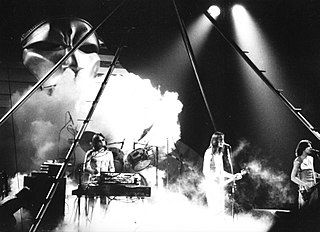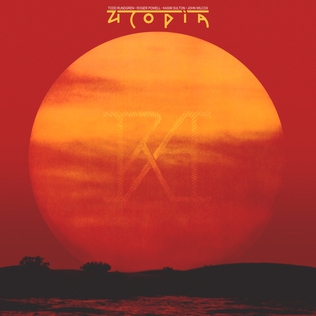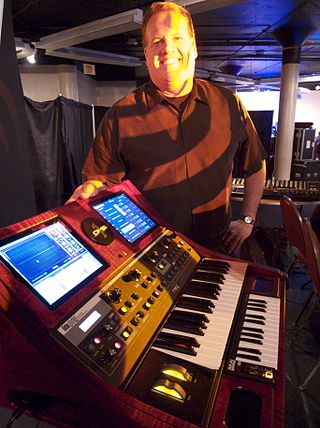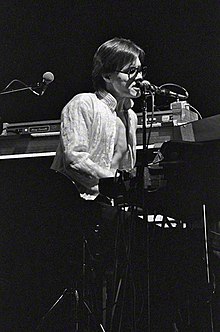
An electronic musical instrument or electrophone is a musical instrument that produces sound using electronic circuitry. Such an instrument sounds by outputting an electrical, electronic or digital audio signal that ultimately is plugged into a power amplifier which drives a loudspeaker, creating the sound heard by the performer and listener.

Todd Harry Rundgren is an American musician, singer, songwriter, and record producer who has performed a diverse range of styles as a solo artist and as a member of the bands Nazz and Utopia. He is known for his sophisticated and often unorthodox music, his occasionally lavish stage shows, and his later experiments with interactive art. He also produced music videos and was an early adopter and promoter of various computer technologies, such as using the Internet as a means of music distribution in the late 1990s.

ARP Instruments, Inc. was a Lexington, Massachusetts manufacturer of electronic musical instruments, founded by Alan Robert Pearlman in 1969. It created a popular and commercially successful range of synthesizers throughout the 1970s before declaring bankruptcy in 1981. The company earned a reputation for producing excellent sounding, innovative instruments and was granted several patents for the technology it developed.

Electronic Sound is the second studio album by the English rock musician George Harrison. Released in May 1969, it was the last of two LPs issued on the Beatles' short-lived Zapple record label, a subsidiary of Apple Records that specialised in the avant-garde. The album is an experimental work comprising two lengthy pieces performed on a Moog 3-series synthesizer. It was one of the first electronic music albums by a rock musician, made at a time when the Moog was usually played by dedicated exponents of the technology. Harrison subsequently introduced the Moog to the Beatles' sound, and the band featured synthesizer for the first time on their 1969 album Abbey Road.

David Joseph Smith was an American engineer and founder of the synthesizer company Sequential. Smith created the first polyphonic synthesizer with fully programmable memory, the Prophet-5, which had a major impact on the music industry. He also led the development of MIDI, a standard interface protocol for synchronizing electronic instruments and audio equipment.

Initiation is the sixth album by American musician Todd Rundgren, released May 23, 1975 on Bearsville Records. With this album, Rundgren fully embraced the synthesized prog sound he had begun exploring in more depth in his work with his band Utopia. However, unlike Utopia, in which Rundgren had limited himself to playing guitar, much of the synthesizers on Initiation were played and programmed by Rundgren himself.

Faithful is the seventh studio album by Todd Rundgren, released in May 1976.

Utopia was an American rock band formed in 1973 by Todd Rundgren. During its first three years, the group was a progressive rock band with a somewhat fluid membership known as Todd Rundgren's Utopia. Most of the members in this early incarnation also played on Rundgren's solo albums of the period up to 1975. By 1976, the group was known simply as Utopia and featured a stable quartet of Rundgren, Kasim Sulton, Roger Powell and John "Willie" Wilcox. This version of the group gradually abandoned progressive rock for more straightforward rock and pop.

Back to the Bars is a live album by rock musician Todd Rundgren, which was released as a double LP in 1978.

Another Live is a live album by the progressive rock band Utopia. It was recorded in August 1975 and released in 1975 on Bearsville.

A synthesizer is an electronic musical instrument that generates audio signals. Synthesizers typically create sounds by generating waveforms through methods including subtractive synthesis, additive synthesis and frequency modulation synthesis. These sounds may be altered by components such as filters, which cut or boost frequencies; envelopes, which control articulation, or how notes begin and end; and low-frequency oscillators, which modulate parameters such as pitch, volume, or filter characteristics affecting timbre. Synthesizers are typically played with keyboards or controlled by sequencers, software or other instruments, and may be synchronized to other equipment via MIDI.

Ra is the second studio album and third release by Utopia on Bearsville Records, released in 1977. Band leader Todd Rundgren planned on releasing the LP in 1976 on his own label, Ethereal Records, as the new four-piece line up was not signed to Bearsville. Replete with an elaborate $250,000 stage show featuring a 22-foot-tall (6.7 m) pyramid and golden sphinx which took 18 months of prep, Ra was Rundgren's most ambitious live undertaking.
Gary Tanin is a veteran Milwaukee musician/producer/engineer with a career spanning decades and reflecting two central themes: music and technology.

Todd Rundgren's Utopia is the debut album by the American rock band Utopia, released in October 1974 on Bearsville Records. The band was formed in 1973 by musician, songwriter, and producer Todd Rundgren who decided to expand his musical style by moving from pop-oriented rock towards progressive rock. He assembled a six-piece group that featured three keyboardists and toured as a live act. Most of the album was recorded in the studio except "Utopia", the opening track, which was recorded live in concert April 25th, 1974.

Eric Persing is an American sound designer, professional synthesist, keyboardist, recording artist and music producer based in Los Angeles, California. He is best known as the Founder and Creative Director of the music software and virtual instrument company Spectrasonics. Recognized as one of the world’s most preeminent synth sound designers, Persing has created over a million sounds that inspire music makers around the world. He has been the producer and primary contributor to all of Spectrasonics' products, including the award-winning Omnisphere, Keyscape, Trilian, and Stylus RMX. Earlier work includes other notable Spectrasonics products like Atmosphere, Trilogy, and Distorted Reality.

POV is the ninth and final studio album by the rock group Utopia, released in January 1985. It peaked at #161 on the Billboard 200 charts. Except for a live 1992 reunion album, this was the last album released by Utopia, and Rundgren's final studio work under the Utopia banner.

L is the second studio album by British progressive rock musician Steve Hillage, released by Virgin Records in September 1976.
Mark "Moogy" Klingman was an American musician and songwriter. He was a founding member of Todd Rundgren's band, Todd Rundgren's Utopia, and later became a solo recording artist, bandleader and songwriter. He released two solo recordings, and his songs have been covered by artists as wide-ranging as Johnny Winter, Carly Simon, James Cotton, Thelma Houston, Eric Clapton, Barry Manilow and Guns N' Roses. He played on stage with Jimi Hendrix, Chuck Berry, Luther Vandross, Lou Reed, Jeff Beck and Allan Woody & Warren Haynes of the Allman Brothers and Gov't Mule. Other than Rundgren, his longest musical association may have been with Bette Midler, for whom he served as band leader and who adopted for her signature song "(You Gotta Have) Friends", composed by Klingman and William "Buzzy" Linhart.
Patrick Gleeson is an American musician, synthesizer pioneer, composer, and producer.

Disco Jets is a tongue in cheek project organized and recorded by Todd Rundgren and Utopia shortly after recording Rundgren's Faithful LP and including most of the musicians from those sessions. It's an instrumental recording humorously parodying 1976's US Bicentennial celebrations, disco music, science fiction films and the CB radio fads. It was released in 2001, 25 years after its recording, as part of the Todd Archive Series Vol. 4 – "Todd Rundgren Demos and Lost Albums" 2-CD set on Rhino Entertainment/Crown Japan. It was reissued in 2012 as a standalone CD import on Esoteric Recordings and in 2015 on Cherry Red. It was also released as a limited edition vinyl that was manufactured exclusively by Cherry Red for Record Store Day, only appearing in record shops from Saturday 16 April.

















